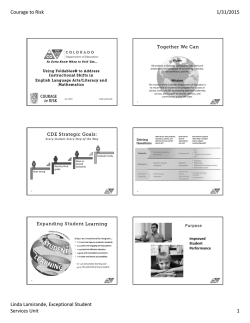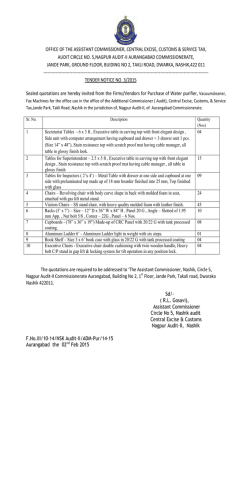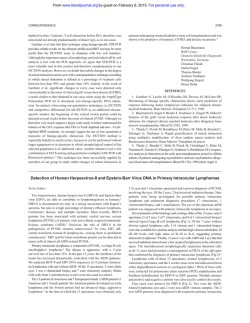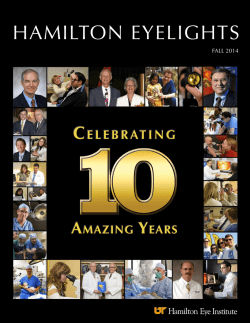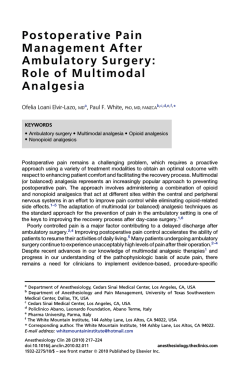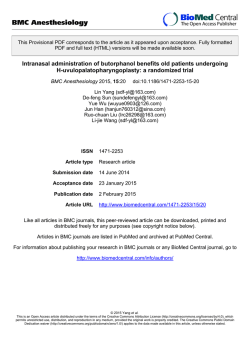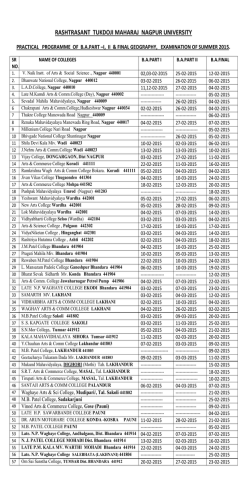
Download [ PDF ] - journal of evolution of medical and dental sciences
DOI: 10.14260/jemds/2015/207
ORIGINAL ARTICLE
SURGICALLY INDUCED ASTIGMATISM AFTER IMPLANTATION OF
FOLDABLE AND NON-FOLDABLE LENSES IN CATARACT SURGERY BY
PHACOEMULSIFICATION
Vikas Mahatme1, Lubna Rahman2, Chitra Pande3, Nikhilesh Wairagade4, Rajesh Singare5, M. D. Pawar6,
Seema Deshmukh7
HOW TO CITE THIS ARTICLE:
Vikas Mahatme, Lubna Rahman, Chitra Pande, Nikhilesh Wairagade, Rajesh Singare, M. D. Pawar, Seema
Deshmukh. “Surgically Induced Astigmatism after Implantation of Foldable and Non-Foldable Lenses in
Cataract Surgery by Phacoemulsification”. Journal of Evolution of Medical and Dental Sciences 2015; Vol. 4,
Issue 09, January 29; Page: 1474-1479, DOI: 10.14260/jemds/2015/207
ABSTRACT: This prospective comparative study included 300 matched patients of different grades of
senile cataract. All of them willfully underwent phacoemulsification at the hands of a single
experienced surgeon, performing with a single and individual technique {Woodcutter’s technique1};
half of them were implanted with a foldable intraocular lens and the other half with a non-foldable
PMMA intraocular lens. All the patients undergoing phacoemulsification had an improvement in
vision. There was no statistically significant difference in the surgically induced astigmatism after
implanting foldable or non-foldable IOL.
KEYWORDS: Phacoemulsification, Cataract surgery, Foldable IOL, Non foldable phaco IOL,
Astigmatism, Keratometry, Woodcutter’s technique.
INTRODUCTION: Phacoemulsification devised by Charles Kelman, MD, in early 19662 has reduced
the trauma to the eye and has improved the stability to the corneal shape. Introduction of the foldable
intraocular lens by Dr. Mazzocca,3 allows us to take full advantage of the small incision of
phacoemulsification. This prospective comparative study included 300 matched patients of different
grades of senile cataract. All of them willfully underwent phacoemulsification at the hands of a single
experienced surgeon, performing with a single and individual technique {Woodcutter’s technique1};
half of them were implanted with a foldable intraocular lens and the other half with a non-foldable
PMMA intraocular lens. The study aimed at calculating and comparing surgically induced astigmatism
after implantation of foldable and non-foldable intraocular lenses.
MATERIALS AND METHODS: This prospective, hospital based comparative study of 300 matched
patients of senile cataract of various grades, operated by single phacoemulsification technique by a
single experienced surgeon was carried out at Mahatme Eye Bank and Eye Hospital, Nagpur, India
between May 2004 and May 2005 after ethical committee’s approval.
The patients were divided into 2 groups, first group of 150 being implanted with a foldable
{poly-HEMA} and the other 150 patients being implanted with a non-foldable rigid PMMA intraocular
lens.
Sample size was calculated by considering confidence interval of 90% at 5% significance.
INCLUSION CRITERIA: Patients with operable senile cataract of all grades.
J of Evolution of Med and Dent Sci/ eISSN- 2278-4802, pISSN- 2278-4748/ Vol. 4/ Issue 09/Jan 29, 2015
Page 1474
DOI: 10.14260/jemds/2015/207
ORIGINAL ARTICLE
EXCLUSION CRITERIA: Patients having any of the following were excluded from the study.
Congenital, traumatic or complicated cataract.
Pre-existing glaucoma {primary or secondary}.
Subluxation or pseudoexfoliation.
Pre-existing corneal pathology.
Uveitis.
High myopia with degenerative changes.
Posterior segment pathology, mainly diabetic or hypertensive retinopathy or macular
pathology.
Blind opposite eye.
PREOPERATIVE OPHTHALMIC EVALUATION: Included.
a. Visual acuity:
1. Unaided.
2. Best corrected.
3. With spectacles.
b. Intraocular pressure with {Perkin’s} applanation tonometer.
c. Detailed slit lamp biomicroscopic examination of the eye.
d. Detailed fundus examination with the aid of a direct and indirect ophthalmoscopes and a 90
Dioptre lens.
e. Retinoscopy.
f. Patency of the lacrimal system {syringing}.
g. Keratometry with the aid of auto-keratometer.
h. IOL power calculation and axial length by A-scan using SRK-II formula.
POSTOPERATIVE EVALUATION WAS DONE:
1. Prior to discharge.
2. Second postoperative day.
3. At end of 1 week.
4. At end of 1 month.
5. At the end of 6 weeks.
Spectacle correction was given at end of a week and surgically induced astigmatism
calculated at the end of 6 weeks by Vector analysis as described by Jaffe and Clayman.4
OBSERVATIONS: Table 1 shows the variety of cataracts included in the study group. Posterior
subcapsular cataracts were the most common and nuclear sclerosis of grade three was the next
common in frequency in both the groups. Only two cases of hypermature cataract were included,
one in either group was found.
GRADE
Cataract
Foldable
Percent
1
2
NS1
NS2
3
20
2.00
13.33
Non
Foldable
1
30
Percent
TOTAL
0.67
20.00
4
50
J of Evolution of Med and Dent Sci/ eISSN- 2278-4802, pISSN- 2278-4748/ Vol. 4/ Issue 09/Jan 29, 2015
Page 1475
DOI: 10.14260/jemds/2015/207
ORIGINAL ARTICLE
3
4
5
6
7
8
9
10
11
12
13
14
15
16
NS3
PSC
PPC
MAT
NS1+PSC
NS2+PSC
NS3+PSC
NS+PPC
ASC+NS
HMSC
NS4
NS+CC
NMSC
PSC+PPC
24
29
9
17
4
25
4
5
1
1
3
2
3
0
16.00
19.33
6.00
11.33
2.67
16.67
2.67
3.33
0.67
0.67
2.00
1.33
2.00
0.00
21
42
6
13
3
7
5
1
1
1
10
1
6
2
14.00
28.00
4.00
8.67
2.00
4.67
3.33
0.67
0.67
0.67
6.67
0.67
4.00
1.33
45
71
15
30
7
32
9
6
2
2
13
3
9
2
Table 1: DISTRIBUTION OF VARIOUS TYPES OF CATARACT IN THE TWO GROUPS
Postop astigmatism Foldable Non-Foldable TOTAL
ZERO
1
0
1
upto 0.5
22
8
30
0.51-1.00
64
40
104
1.01-1.5
44
47
91
1.51-2.00
16
34
50
>2.00
3
21
24
TOTAL
150
150
Table 2: POSTOPERATIVE ASTIGMATISM ON KERATOMETRY
The above table 2 of postoperative astigmatism on keratometry was analysed by Graph-pad
prism in following manner.
FISHER’S EXACT TEST
P<0.0001
***
Two sided
P value
P value summary
One or two sided
Statistically significant?
Yes
(alpha < 0.05)
STRENGTH OF ASSOCIATION
Relative risk
2.258
99% confidence interval 1.329 to 3.836
Odds ratio
3.992
99% confidence interval 1.851 to 8.609
J of Evolution of Med and Dent Sci/ eISSN- 2278-4802, pISSN- 2278-4748/ Vol. 4/ Issue 09/Jan 29, 2015
Page 1476
DOI: 10.14260/jemds/2015/207
ORIGINAL ARTICLE
Data Analysed
Less than 1.5
More than 1.5
Total
Foldable Group Non-Foldable Group Total
131
95
226
19
55
74
150
150
300
When calculated on keratometry alone, 131 patients in the foldable group and 95 patients in
the non-foldable group showed a postoperative astigmatism of less than 1.5. On the other hand, 19
patients in the foldable group and 55 patients in the non-foldable group showed a postoperative
astigmatism of more than 1.5. This difference in the values for the two groups was statistically
significant at p<0.0001 by applying Fisher’s exact test.
Surgically induced
Foldable group Non-Foldable group TOTAL
Astigmatism
Upto 0.5
50
42
92
0.51-1.00
63
65
128
1.01-1.5
27
33
60
1.51-2.00
10
8
18
>2.00
0
2
2
SIA
Foldable
Non-Foldable
TOTAL
less than 1.5
140
140
more than 1.5
10
10
Table 3: SURGICALLY INDUCED ASTIGMATISM ON VECTOR ANALYSIS
The values for the surgically induced astigmatism for the two groups were identical when
divided further into two categories of less than or more than 1.5. Thus, we could infer that there was
no statistically significant difference in the surgically induced astigmatism whether a foldable polyHEMA or a rigid PMMA intraocular lens is implanted following phacoemulsification.
Astigmatism on acceptance
of refraction
Zero
upto 0.5
0.75-1
1.25-1.5
>1.5
Foldable
Non Foldable
TOTAL
63
31
37
15
4
52
30
44
15
9
115
61
81
30
13
Table 4: POSTOPERATIVE ACCEPTANCE OF ASTIGMATIC CORRECTION
The above table 4 of postoperative acceptance of astigmatic correction was analysed by
Graph-pad prism in following manner.
J of Evolution of Med and Dent Sci/ eISSN- 2278-4802, pISSN- 2278-4748/ Vol. 4/ Issue 09/Jan 29, 2015
Page 1477
DOI: 10.14260/jemds/2015/207
ORIGINAL ARTICLE
FISHER’S EXACT TEST
P value
0.256
P value summary
NS
One or two sided
Two sided
Statistically significant?
NO
(alpha < 0.05)
STRENGTH OF ASSOCIATION
Relative risk
1.653
95% confidence interval 0.7256 to 3.767
Odds ratio
2.33
95% confidence interval 0.7013 to 7.740
Data Analysed
Foldable Group Non-Foldable Group Total
Less than 1.5
146
141
287
More than 1.5
4
9
13
Total
150
150
300
There was no statistically significant difference in the acceptance of astigmatism shown by
patients of either group (p = 0.256). In the foldable group 146 patients accepted an astigmatic
correction of less than 1.5 and 4 patients showed an acceptance of more than 1.5.
On the other side, in the non-foldable group, 141 patients accepted an astigmatic correction of
less than 1.5 and 9 patients accepted a value of more than 1.5.
DISCUSSION: Postoperative astigmatism calculated solely on keratometric readings showed that
astigmatism was present in both these groups. Maximum number of eyes, 64 patients from the
foldable and 40 from the non-foldable group, had astigmatism within the range of 0.51-1.00 D. The
non-foldable group showed an increase in the number of patients with astigmatism beyond 1.00 D.
This may be explained by the larger corneal incision (5.20mm) for implanting a non-foldable lens of
size 5.25mm. The keratometric difference postoperatively was analyzed using Fisher’s exact test, at a
confidence interval of 95% and it was found to be significant at p<0.05. it showed the relative risk of
developing astigmatism of 1.883 if a non-foldable lens was implanted.
Surgically induced astigmatism (SIA) calculated by vector analysis showed no statistically
significant difference between the two groups. 140 patients in either groups had an SIA of < 1.5 D and
10 patients in either groups had SIA of >1.5 D. This effect may just be because the temporal incision is
away from the visual axis and it is on the steeper meridian as compared to the superior incision. John
Merrian C.et al5 in their study of the effect of incisions for cataract surgery on the corneal curvature
have inferred that there was significant change in the corneal curvature when the incision was taken
on the temporal clear cornea.
Postoperative keratometry in both the groups showed astigmatism in all the patients.
Statistical analysis by Fisher two paired test also showed statistically significant difference in the
astigmatism between the two groups at p < 0.0001. When patients were refracted after 10 days of
surgery, 63 patients in the foldable group and 52 patients in the non-foldable group did not accept
J of Evolution of Med and Dent Sci/ eISSN- 2278-4802, pISSN- 2278-4748/ Vol. 4/ Issue 09/Jan 29, 2015
Page 1478
DOI: 10.14260/jemds/2015/207
ORIGINAL ARTICLE
any cylindrical correction. 52 patients in the foldable group and 59 patients in the non-foldable group
accepted a cylindrical correction of 0.75-1.5 D. No patient required a high cylindrical acceptance.
CONCLUSION: Consistent and reproducible outcome can be obtained after phacoemulsification in all
grades of cataract by a single technique. There was no statistically significant difference in the
astigmatism after implantation of foldable and non-foldable lenses. This study opens the doors to
explore the feasibility of using non-foldable lenses in phacoemulsification as a cost effective
technique for community eye care programs.
REFERENCES:
1. Mahatme V: Step by step Phaco Tips and Tricks. Jaypee 2005; 83-105.
2. Charles D. Kelman: Thirty years of phacoemulsification: the evolution of my technique from
1967 to 1997, Phacoemulsification: Principles and Techniques, Slack incorporated, 1998; 1:
465.
3. Kratz R, Mazzocco T, Davidson B: The consecutive implantation of 250 Shearing intraocular
lenses. Contact Intraocular Lens Med J, 1979; 5: 123.
4. Jaffe NS, Clayman HM: The pathophysiology of corneal astigmatism after cataract extraction.
Trans Am Acad Ophthalmol Otolaryngol.1975; 79: 615-630.
5. Merriam J C, Zheng L, Merriam J E, Zaider M, Lindstrom B: The effect of incision for cataract on
corneal curvature. Ophthalmology. 2003; 110: 1807-1813.
AUTHORS:
1. Vikas Mahatme
2. Lubna Rahman
3. Chitra Pande
4. Nikhilesh Wairagade
5. Rajesh Singare
6. M. D. Pawar
7. Seema Deshmukh
PARTICULARS OF CONTRIBUTORS:
1. Founder Medical Director, Department of
Ophthalmology, Mahatme Eye Bank Eye
Hospital, Nagpur.
2. Consultant Ophthalmologist, Department
of Ophthalmology, Mahatme Eye Bank
Eye Hospital, Nagpur.
3. Senior Consultant, Department of
Ophthalmology, Mahatme Eye Bank, Eye
Hospital, Nagpur.
4. Senior Consultant, Department of
Ophthalmology, Mahatme Eye Bank, Eye
Hospital, Nagpur.
5.
6.
7.
Professor & Senior Consultant, Department
of Ophthalmology, Mahatme Eye Bank, Eye
Hospital, Nagpur.
Professor & Senior Consultant, Department
of Ophthalmology, Mahatme Eye Bank, Eye
Hospital, Nagpur.
Ex-Consultant, Department of
Ophthalmology, Mahatme Eye Bank, Eye
Hospital, Nagpur.
NAME ADDRESS EMAIL ID OF THE
CORRESPONDING AUTHOR:
Dr. Vikas Mahatme,
Mahatme Eye Bank Eye Hospital,
# 16, Central Excise Colony,
Ring Road, Chhatrapati Square, Nagpur.
E-mail: [email protected]
Date of Submission: 24/12/2014.
Date of Peer Review: 26/12/2014.
Date of Acceptance: 19/01/2015.
Date of Publishing: 27/01/2015.
J of Evolution of Med and Dent Sci/ eISSN- 2278-4802, pISSN- 2278-4748/ Vol. 4/ Issue 09/Jan 29, 2015
Page 1479
© Copyright 2026
